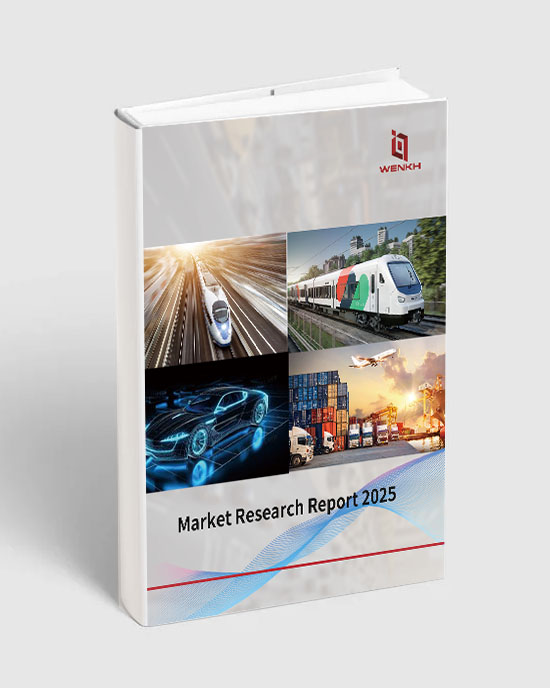
Global Passenger Railway Infrastructure Maintenance Market Size, Competition Landscape and Supply Chain Research Report 2025



RResearch Summary
Passenger railway infrastructure maintenance refers to the ongoing activities and procedures dedicated to preserving the safety, functionality, and reliability of the railway systems used for passenger trains. This maintenance encompasses a wide range of tasks, including track inspection and repair, signal and communication system maintenance, maintenance of overhead electrification systems (if applicable), and station upkeep. These efforts are vital to ensuring that passenger railways operate efficiently, minimizing the risk of accidents, delays, or service interruptions. Regular maintenance and inspections of railway tracks, bridges, tunnels, and associated infrastructure contribute to the safety and comfort of passengers and help maintain the overall quality of service in passenger rail transportation.
According to WENKH research statistics, the global Passenger Railway Infrastructure Maintenance market sales revenue reached Million USD in 2024 and is expected to reach Million USD by 2032, with a compound annual growth rate (CAGR) of % from 2025 to 2032. Among them, the Asia-Pacific Passenger Railway Infrastructure Maintenance market has experienced rapid changes in recent years, reaching Million USD in 2024, accounting for approximately % of the global market share. It is projected to reach Million USD by 2032.
The global Passenger Railway Infrastructure Maintenance market is highly competitive, with key market players including China Railway Corporation, Network Rail, Deutsche Bahn AG, SNCF, Indian Railway, East Japan Railway Company, FS Group, Russian Railways, West Japan Railway Company, Central Japan Railway Company, ADIF, Amtrak, etc. This report categorizes the competitive landscape of the global Passenger Railway Infrastructure Maintenance market into three tiers based on annual revenue, with the top three market players holding approximately % of the total market share.
This report provides an in-depth analysis of the global Passenger Railway Infrastructure Maintenance market, including market size, price trends, market status and future development prospects. It particularly focuses on the market share, product characteristics, pricing, sales revenue, and gross profit margin of major players in the global Passenger Railway Infrastructure Maintenance industry. Additionally, this report provides an in-depth analysis of the market status and future development trends of different product segments of Passenger Railway Infrastructure Maintenance and their downstream application fields.
In terms of data, this report includes a comprehensive time-series dataset. The historical data spans from 2020 to 2024, providing a solid foundation for analyzing past market trends. The year 2025 is used as a base year to accurately assess the current market landscape. Forecast data covers the period from 2026 to 2032, utilizing scientific analysis methods and models to offer forward-looking predictions and insights into the market's future development. This provides valuable reference information for industry participants and stakeholders.
The report covers regions and countries including North America, Europe, China, Asia Pacific (excluding China), Latin America, the Middle East, and Africa. It particularly focuses on the sales revenue of Passenger Railway Infrastructure Maintenance in these regions and countries, as well as the market share of key market players in each region. The report provides an in-depth analysis of the regional distribution and future development trends of the Passenger Railway Infrastructure Maintenance market. By considering local policies, this report evaluates the market prospects of Passenger Railway Infrastructure Maintenance in each region and country, aiming to help companies gain a comprehensive understanding of the industry characteristics and development potential in different regions, optimize regional business layout, and develop precise market strategies to achieve global development goals.
This report places a strong emphasis on data quality and reliability, utilizing diverse and extensive data sources to ensure the accuracy and validity of the information presented. Primary data collection involves multiple channels, including in-depth interviews with senior executives, industry experts, supply chain stakeholders, and end consumers. These interviews provide key insights into corporate strategic planning, industry policy interpretation, supply chain dynamics, and end-user experiences. Secondary data sources cover a wide range of authoritative statistics from government agencies, customs databases, industry associations, third-party paid databases, brokerage research reports, academic research findings, corporate annual reports, financial statements, real-time news updates, and relevant information from international organizations. These data sources serve as a solid foundation for verification and analysis.
Companies Covered
China Railway Corporation
Network Rail
Deutsche Bahn AG
SNCF
Indian Railway
East Japan Railway Company
FS Group
Russian Railways
West Japan Railway Company
Central Japan Railway Company
ADIF
Amtrak
Product Segment
Track
Signaling
Civils
Others
Product Application
Renewal
Maintenance
Chapter Scope
Chapter 1: Product Statistical Scope, Product Segmentation Types and Downstream Applications, Overall Market Size, Current Status and Development Prospects
Chapter 2: Global Passenger Railway Infrastructure Maintenance Industry Chain Analysis
Chapter 3: Global Passenger Railway Infrastructure Maintenance Industry Environment Analysis and Porter's Five Forces Analysis
Chapter 4: Analysis of the Competitive Landscape of Major Companies in the Global Passenger Railway Infrastructure Maintenance Market (Market Share, Product Revenue Comparison, Tier Division, Corporate Expansion and M&A Trends)
Chapter 5: Analysis of Global Major Companies (Company Profiles, Product Features and Product Segment, Product Revenue, Product Average Price, Gross Profit Margin and Geographical Sales Share)
Chapter 6: Global Passenger Railway Infrastructure Maintenance Product Segment and Downstream Application Size Analysis and Major Regional Market Size Analysis
Chapter 7: North America Passenger Railway Infrastructure Maintenance Product Segment, Downstream Application, and Major Countries Market Size Analysis
Chapter 8: Europe Passenger Railway Infrastructure Maintenance Product Segment, Downstream Application, and Major Countries Market Size Analysis
Chapter 9: China Passenger Railway Infrastructure Maintenance Product Segment, Downstream Application, and Major Countries Market Size Analysis
Chapter 10: Asia Pacific (excluding China) Passenger Railway Infrastructure Maintenance Product Segment, Downstream Application, and Major Countries Market Size Analysis
Chapter 11: Latin America Passenger Railway Infrastructure Maintenance Product Segment, Downstream Application, and Major Countries Market Size Analysis
Chapter 12: Middle East and Africa Passenger Railway Infrastructure Maintenance Product Segment, Downstream Application, and Major Countries Market Size Analysis
Chapter 13: Research Conclusion
Chapter 14: Methodology and Data Source
Purpose and Value of the Report
Market Trend Insights: Analyze industry trends, market dynamics, and future growth potential to help companies forecast changes and develop strategic plans.
Competitive Landscape Analysis: Understand key players' revenue segmentation, strategies, market share, and business models to guide competitive decisions.
Investment Decision Support: Provide feasibility analysis through market size, growth rate, demand trends, and potential risks for informed investment decisions.
Target Customer and Demand Analysis: Examine consumer behavior, purchasing preferences, and pain points to optimize products and improve market penetration.
Policy and Regulatory Insights: Interpret relevant industry policies to ensure compliance and mitigate regulatory risks.
Business Model Optimization: Offer data-driven suggestions for enhancing business models and improving profitability.




